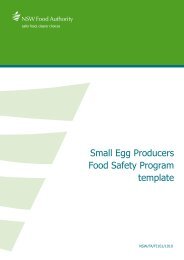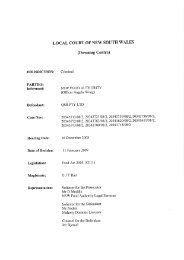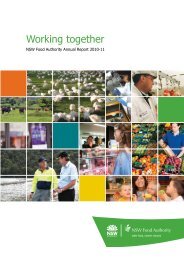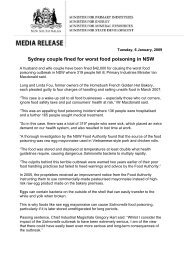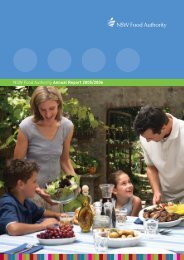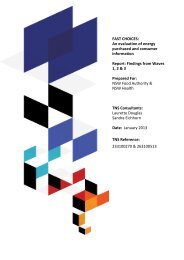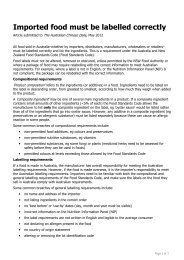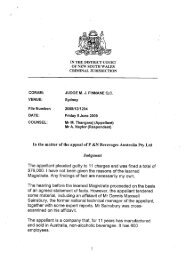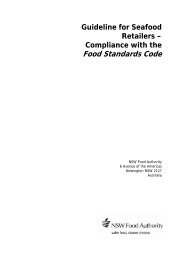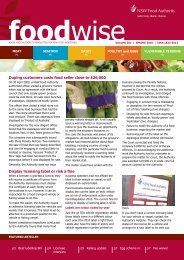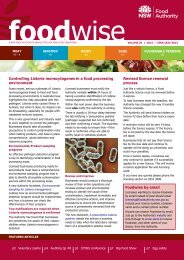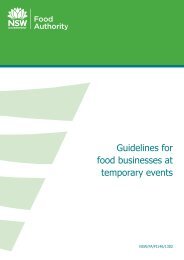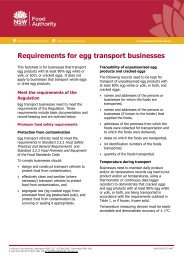General circular 03/2008 - NSW Food Authority
General circular 03/2008 - NSW Food Authority
General circular 03/2008 - NSW Food Authority
Create successful ePaper yourself
Turn your PDF publications into a flip-book with our unique Google optimized e-Paper software.
GENERAL CIRCULARThis general <strong>circular</strong> contains important information from the<strong>NSW</strong> <strong>Food</strong> <strong>Authority</strong> for seafood store licensees.Please take the time to read this information.If you have any queries, please contactPeter Day, Manager, Audit & Compliance on 02 9741 48<strong>03</strong><strong>General</strong> Circular <strong>03</strong>/<strong>2008</strong> Issued 4 April <strong>2008</strong>
<strong>General</strong> Circular <strong>03</strong>/<strong>2008</strong>To:Subject:All seafood store licensees<strong>Food</strong> safety program and auditing requirementsPURPOSEThe purpose of this <strong>circular</strong> is to advise seafood stores on changes in requirements forthem to operate under an audited food safety program.As a result of the implementation of the 'Primary Production and Processing Standard forSeafood' (Standard 4.2.1) and subsequent amendments introduced by the <strong>Food</strong>Amendment Act 2007 (<strong>NSW</strong>) on 1 January <strong>2008</strong> the <strong>Authority</strong> has reviewed the priority riskclassification of seafood stores where the activities conducted are limited to receiving,storing and transporting seafood.BACKGROUNDStarting in 2001, seafood businesses other than retail-only businesses have been requiredto be licensed with the <strong>NSW</strong> <strong>Food</strong> <strong>Authority</strong>, previously Safe<strong>Food</strong> Production <strong>NSW</strong>. With theexception of some businesses handling live seafood, they have also been required todevelop and implement a food safety program.Since then, <strong>Food</strong> Standards Australia New Zealand has gazetted the 'Primary Productionand Processing Standard for Seafood' and work has been underway on a national priorityrisk classification system.Primary Production and Processing Standard for SeafoodThe new 'Primary Production and Processing Standard for Seafood' sets consistent nationalfood safety requirements for seafood primary production and processing businesses.In summary, the standard requires:• all primary production and processing seafood businesses in Australia to comply withoutcome-based food safety requirements relating too harvest or collection, handling, processing, storage, transportation andtraceability of seafoodo condition and maintenance of food premises and equipment; and• businesses handling bivalve molluscs to develop and implement a food safety program.The new standard is not applicable to businesses manufacturing certain seafood productssuch as smoking, canning, crumbing or where other ingredients are added nor to retail saleactivities. These businesses will still be required to comply with <strong>Food</strong> Standards CodeStandards 3.2.2 and 3.2.3.<strong>General</strong> Circular <strong>03</strong>/<strong>2008</strong> Page 2 of 3
Priority Classification SystemA national priority classification system has been developed following initial work donewithin the <strong>NSW</strong> <strong>Food</strong> <strong>Authority</strong>. The system will be a guide for state agencies inimplementing food safety management systems, including in some cases the need for afood safety program.The priority classification system identifies the following seafood activities as medium tohigh priority:• commercial shellfish harvesting• oyster opening and• seafood smoking• seafood processors engaged in cooking, gutting/gilling/slicing ofseafoodAll other seafood business activities are identified at a lower priority.P1P2PRESENT POSITIONThe <strong>NSW</strong> <strong>Food</strong> <strong>Authority</strong> intends to require all seafood processors classified as P1 and P2 todevelop and implement a food safety program where either a current food safety schemeexists or if a cost benefit analysis identifies this outcome as beneficial. Where a businessconducts processing operations with different priority risk classifications then the higherpriority ranking will determine the food safety program requirements for that business.As a result, premises in <strong>NSW</strong> that are licensed as a 'seafood store' and only receive, storeor transport seafood will no longer be subject to audits or be required to maintain anapproved food safety program. Such businesses will still:• require a <strong>NSW</strong> <strong>Food</strong> <strong>Authority</strong> licence• comply with <strong>Food</strong> Safety Standrads 3.2.2 and 3.2.3 relating to hygiene andstructural requirements respectively, and• be subject to an inspection program as per the <strong>Authority</strong> verification protocol.ENQUIRIESPlease direct any enquiries to:Contact Phone FaxPeter DayManager, Audit & Compliancepeter.day@foodauthority.nsw.gov.au(02)9741 48<strong>03</strong>0419 616 378(02)9741 4898Ed KraaExecutive Director, Compliance, Investigation and Enforcement Branch<strong>General</strong> Circular <strong>03</strong>/<strong>2008</strong> Page 3 of 3



